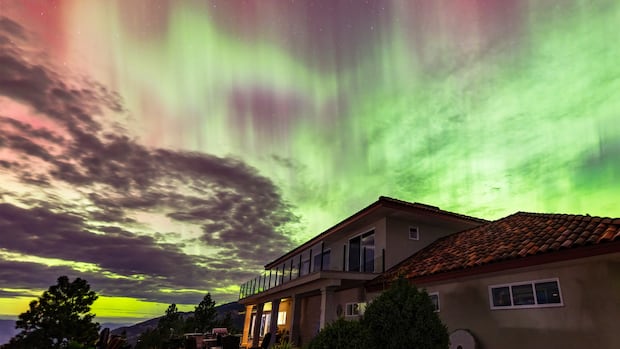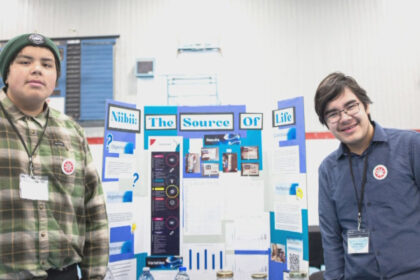ScienceThe sun has coughed up three coronal mass ejections which, if Earth-directed, can produce the beautiful northern lights, and it seems that they are heading our way.The Space Weather Prediction Center is forecasting a moderate storm for ThursdayNicole Mortillaro · CBC News · Posted: Oct 16, 2025 4:00 AM EDT | Last Updated: 6 hours agoAn intense display of the northern lights is seen over on Anarchist Mountain in the southern interior of British Columbia in October 2024. There’s a chance that Canada could be in for a light show Thursday night. (Debra Ceravolo)There’s a chance that Canada could be in for a light show Thursday night.The sun has fired off three coronal mass ejections (CME) that are on their way toward Earth.CMEs are large expulsions of particles from the sun that travel faster than normal on the solar wind. When those particles reach Earth, they interact with our magnetic field and can create beautiful northern lights, also known as the aurora borealis (or if you’re in the southern hemisphere, aurora australis).They often occur following a solar flare, where the magnetic fields get entangled and then snap, releasing intense bursts of radiation, which can disrupt high-frequency radio signals here on Earth.“We have three Earth-directed solar storms that are kind of back to back to back, all within the last 24 to 36 hours,” Tamitha Skov, a space weather physicist and professor at Millersville University in Pennsylvania, in a YouTube update.All three of the CMEs were released from the same sunspot area, dubbed 4246. Several sunspots dot the sun’s surface. One of the more active regions has been 4246. (NASA/SDO/Spaceweather.com)According to the U.S. National Oceanic and Atmospheric Administration’s Space Weather Prediction Center (SWPC), there is the chance for a moderate geomagnetic storm late on Oct. 16 Greenwich mean time, which is four hours ahead of eastern daylight saving time, and seven hours of pacific daylight saving time.That means it could be a problem for those in the west who hope to catch the show.Though, take some solace: It’s very difficult to predict exactly when the storm could hit. It could be earlier or even later than forecast.But the SWPC also noted that the storm could perhaps go into Friday, though it would likely be a weaker storm.Manage expectationsIf you’re expecting a show like those that took place in May and October 2024, this storm won’t be as strong.The geomagnetic storm scale goes from G1 to G5, with G5 being considered extreme, which is what we saw with those storms last year. The “northern” lights were seen across cities and all the way down to the Caribbean.For this storm, the SWPC is forecasting a G2, which is considered moderate.Still, you can increase your chances of catching them by trying to get to a dark-sky location, away from city lights, with a good view of the northern horizon.But a few things have to line up in order for the northern lights to be visible farther south in latitude than where they normally are visible, particularly in the far north.First, the CMEs have to be Earth-directed, which they appear to be. Second, the solar wind must be very fast. And probably most importantly, the auroral hole — along which the particles travel — must be dipping south. The further south it dips, the farther south they will be visible.If you want to know if the aurora borealis is visible in your location, you can download apps like Aurora Alerts and Aurora Forecast.ABOUT THE AUTHORBased in Toronto, Nicole covers all things science for CBC News. As an amateur astronomer, Nicole can be found looking up at the night sky appreciating the marvels of our universe. She is the editor of the Journal of the Royal Astronomical Society of Canada and the author of several books. In 2021, she won the Kavli Science Journalism Award from the American Association for the Advancement of Science for a Quirks and Quarks audio special on the history and future of Black people in science. You can send her story ideas at nicole.mortillaro@cbc.ca.Follow Nicole Mortillaro on Twitter
Wednesday, 17 Dec 2025
Canada – The Illusion
Search
Have an existing account?
Sign In
© 2022 Foxiz News Network. Ruby Design Company. All Rights Reserved.
You May also Like
- More News:
- history
- Standing Bear Network
- John Gonzalez
- ᐊᔭᐦᑊ ayahp — It happened
- Creation
- Beneath the Water
- Olympic gold medal
- Jim Thorpe
- type O blood
- the bringer of life
- Raven
- Wás’agi
- NoiseCat
- 'Sugarcane'
- The rivers still sing
- ᑲᓂᐸᐏᐟ ᒪᐢᑿ
- ᐅᑳᐤ okâw — We remember
- ᐊᓂᓈᐯᐃᐧᐣ aninâpêwin — Truth
- This is what it means to be human.
- Nokoma











